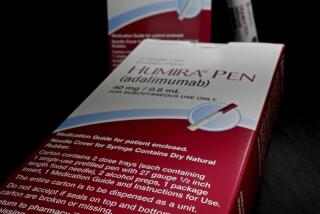Over-Counter Drugs May Cost You More
- Share via
Contrary to traditional wisdom, though nonprescription, over-the-counter drugs ultimately save consumers money, they may actually cost more than their prescription-only versions.
Prescription and nonprescription prices for Gyne-Lotrimin, a cream for treating vaginal yeast infections, were compared in a limited price survey recently conducted by American Health for an article in its current issue on what happens when prescription drugs go over the counter.
The drug received approval to switch to over-the-counter in December, but some outlets still sold the prescription version. The average prescription price in 10 New York City pharmacies was 8% cheaper than the same-size, same-strength over-the-counter version ($18.63 vs. $20.21).
During the past 15 years, the Food and Drug Administration has allowed more than 45 prescription ingredients to be marketed without a prescription. Though surveys on others might well find a price edge for the over-the-counter version, the biggest cost savings from switches come through a less direct route.
Because drug switches account for most of the new products that can be sold without a prescription, they offer consumers more options for self-medication--and fewer trips to the doctor’s office.
Rather than spend time and money ($38 on average) for a visit to the doctor to get a prescription, consumers can simply buy the drug at a pharmacy or supermarket. In this era of increasing self-care, those savings can be considerable.
One study looked at nationwide savings stemming from a single switch: one-half-percent hydrocortisone, a topical anti-itch product most commonly sold under the name Cortaid. In the three years after hydrocortisone first became available, the study found that consumers saved more than $1 billion on doctor visits.
Not surprisingly, doctors don’t always look kindly on drug switches. Recent surveys found that only 57% of doctors favored them.
Loss of business isn’t the only reason. A drug switch means that doctors lose control over a weapon in their medical arsenal. It’s a loss some apparently resent.
Others doubt that the public has the requisite knowledge to self-medicate. Still others fear patients will feel cheated if they leave a physician’s office with a recommendation for an over-the-counter drug rather than a prescription.
Medical resistance to drug switches comes mainly from primary-care physicians. Specialists tend to take a more favorable view, since over-the-counter drugs can satisfy patients who might otherwise take up their time with minor complaints.
Among the clearest beneficiaries of switches are insurance companies, which generally don’t reimburse patients for nonprescription drugs. But for some people enrolled in such plans, switches can be costly.
Consider a woman who, under her company’s health plan, pays only $1 per prescription for Gyne-Lotrimin cream. Her insurer--and most others, including Medicaid--won’t pay for nonprescription drugs.
Unless her doctor is willing to prescribe a prescription substitute, the woman now must pay about $20 for a tube of the over-the-counter product.
More to Read
Inside the business of entertainment
The Wide Shot brings you news, analysis and insights on everything from streaming wars to production — and what it all means for the future.
You may occasionally receive promotional content from the Los Angeles Times.









